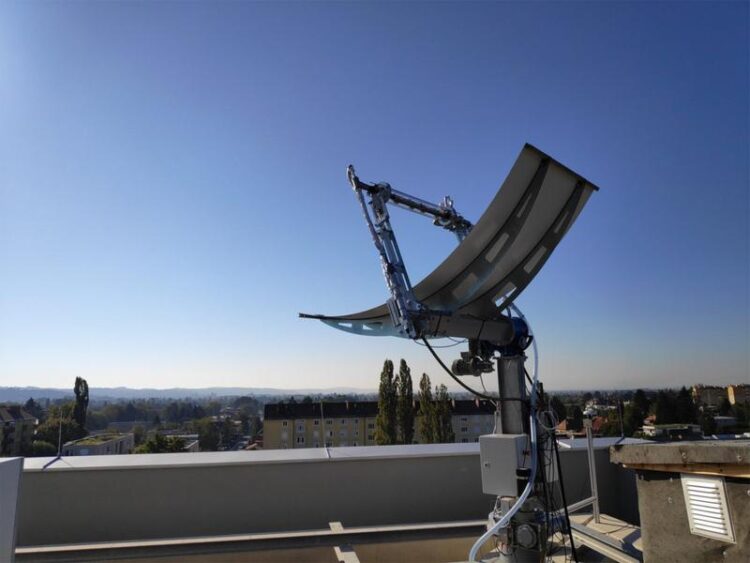Hybrid Electricity and Heat Generation

The parabolic trough collector is manufactured using industrial production methods such as injection moulding.
(c) EMS - TU Graz
Innovative Parabolic Trough Solar Module Developed at TU Graz.
Solar rays focused on concentrator photovoltaic cells using parabolic mirrors not only supply electricity, but also thermal energy for industrial processes, heating or cooling. Three technological innovations significantly reduce costs.
An international team led by Armin Buchroithner from the Institute of Electrical Measurement and Sensor Systems at Graz University of Technology (TU Graz) has developed a parabolic trough collector with cost-effective photovoltaic cells that can be used to generate solar power and thermal energy at the same time.

The parabolic mirror focusses the sunlight onto the photovoltaic cells arranged in the focal line. (c) EMS – TU Graz
The solar module developed consists of a trough-shaped concave mirror that focuses the sun’s rays onto the photovoltaic cells arranged in the focal line. The waste heat from the solar cells is transferred to a heat transfer fluid that flows along the back of the cells in a system of pipes. The thermal and electrical energy generated in this way can, for instance, be used for climate-neutral heating and cooling of buildings or for various industrial purposes, e.g. in the food or textile industry.
Solar radiation is amplified 60- to 120-fold
The idea of generating electricity and heat from solar radiation at the same time has been around since the 1970s, but has not been successful due to high costs and technological problems. This could now change, as Buchroithner’s team has succeeded in developing several technological innovations in the course of the ECOSun – Economic COgeneration by Efficiently COncentrated SUNlight research project. In cooperation with the partner IMK Solarmirrotec, the parabolic trough collectors were manufactured much more efficiently using industrial production methods such as injection moulding technology. The silicon solar cells developed with the Turkish research centre GÜNAM are cost-effective and robust, so that they can withstand the high temperatures of concentrated sunlight. This is an important factor, since the parabolic trough mirrors amplify the solar irradiation by a factor of 60 to 120. The researchers were also able to optimise the cooling of the solar cells, making the waste heat more usable for further applications.
“This approach has the potential to make a significant contribution to the energy transition,” says Armin Buchroithner. So far, parabolic trough solar power plants have been located almost exclusively in particularly sunny regions such as Spain or the Persian Gulf. “However, our tests have shown that it can also be useful here in Austria to replace fossil fuels in industrial processes,” says Buchroithner. “Given the rising energy prices and the desire for energy independence, the importance of independent, efficient, and cost-effective solutions for the supply of electricity and heat is increasing.”
In addition to TU Graz, the ECOSun research consortium includes the Center for Solar Energy Research and Application in Ankara, the Heat and Mass Transfer Technological Centre of the Universitat Politècnica de Catalunya in Barcelona and the industrial partners IMK GmbH Solarmirrortec from Seitenstetten and iTech Solar from Ankara. The research project was funded in equal parts by the Austrian Research Promotion Agency and the European Union within the SOLAR-ERA.NET Cofund programme.
Wissenschaftliche Ansprechpartner:
Armin BUCHROITHNER
Dipl.-Ing. Dr. techn.
TU Graz | Institute of Electrical Measurement and Sensor Systems
Tel. +43 316 873 30514
armin.buchroithner@tugraz.at
Weitere Informationen:
https://www.tugraz.at/en/research/fields-of-expertise/sustainable-systems/overvi… This research is anchored in the Field of Expertise “Sustainable Systems“, one of five strategic foci of TU Graz.
Media Contact
All latest news from the category: Power and Electrical Engineering
This topic covers issues related to energy generation, conversion, transportation and consumption and how the industry is addressing the challenge of energy efficiency in general.
innovations-report provides in-depth and informative reports and articles on subjects ranging from wind energy, fuel cell technology, solar energy, geothermal energy, petroleum, gas, nuclear engineering, alternative energy and energy efficiency to fusion, hydrogen and superconductor technologies.
Newest articles
Faster, more energy-efficient way to manufacture an industrially important chemical
Zirconium combined with silicon nitride enhances the conversion of propane — present in natural gas — needed to create in-demand plastic, polypropylene. Polypropylene is a common type of plastic found…

Energy planning in Ghana as a role model for the world
Improving the resilience of energy systems in the Global South. What criteria should we use to better plan for resilient energy systems? How do socio-economic, technical and climate change related…

Artificial blood vessels could improve heart bypass outcomes
Artificial blood vessels could improve heart bypass outcomes. 3D-printed blood vessels, which closely mimic the properties of human veins, could transform the treatment of cardiovascular diseases. Strong, flexible, gel-like tubes…





















